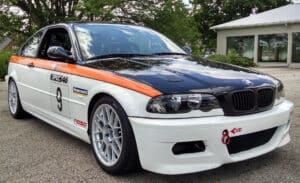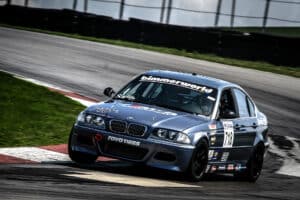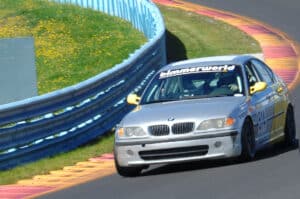
Everything You Wanted to Know About NASA's Spec E46 Racing Series
Spec E46 is one of the newer series in NASA racing, but it’s catching on in a big way. Field sizes are increasing in many regions and Championships fields have soared from virtually nothing in 2015 to double digits in recent years. BMW sold a great deal of E46 cars, so finding a donor shouldn’t be too difficult.
Initial build costs will be greater than some other spec classes, such as Spec Miata, Spec E30 or 944 Spec, and the required parts aren’t inexpensive, but that was known from the start. The series was devised to produce a good racecar, not necessarily a cheap one.
Once the initial build is done, the cars hold up well. Cars with as many as 200,000 miles on them still make viable racecars and run strong enough to set lap records and win races. What’s more, because of an aggressive weight target, just 2,850 pounds, the cars are easy on tires and brakes. Running a Spec E46 registers in the bottom half of a NASA race field in terms of cost, but in the top half in terms of fast laps. That’s where the value lies.
$1,000 to $4,000
The key is finding the combination of a 330i or 330ci with a manual transmission. You can substitute a manual in an automatic car, but that requires additional work and parts, such as pedals, slave cylinder bits and a driveshaft.
Tires, size, brand and prices
Toyo RR 255-40-R17 $249 from Phil’s Tire Service, Cragsmoor, N.Y.
Toyo RA1 235-40-R17 $234 from Phil’s Tire Service, Cragsmoor, N.Y.
Brakes, brands and prices
From Bimmerworld
Check the NASA Contingencies page for the latest programs.
Spec racing, all the cars are the same, one engine, one weight, one tune on a sealed ECU.
There is some freedom within the rules to set up the car to suit you.
Late-model cars at good donor prices, competent chassis and vehicle dynamics, long-lasting engines, vast knowledge base.
Growing class, fields increasing throughout the country and at Championships events.
Spec E46 Resources
Questions and Answers to Feed Your Curiosity
In a spec class, it’s always tempting to call for “cheap” parts on the build sheet. After all, we’re all running the same parts so why spend a lot? With Spec E46, we wanted to make sure the cars performed well, were reliable and easy to maintain, and had enough adjustability so drivers could fine-tune them to match their preferences. So we attempted to strike a balance with the parts selection. Price wasn’t the only consideration.
Take the exhaust, for example. Engineered by Bimmerworld and produced by MagnaFlow, it’s a high-quality stainless item built in multiple sections, with beefy flanges, and strong V-clamps to make installation and removal easy. It includes a straight pipe and a resonator for tracks with stringent noise limits. The MCS adjustable shocks are another good example. Everyone who drives on them raves about their performance, and they have proven to be extremely durable and consistent even after several years and thousands of miles of racing. We’re not trying to be the cheapest series. We’re trying to be the most balanced. Ask almost any Spec E46 racer and he or she will tell you that the rules set is pretty spot-on.
Latest Spec E46 News Around The Country
Wouldn’t it be great if there were a NASA contingency and Member Benefits partner that offered rewards and discounts on hardcore racing parts we […]
Longtime NASA contingency partner Motion Control Suspension has renewed its contingency program for 2024. One new addition to the program is that […]
In the heated battles of the Spec E46 class at Chuckwalla Raceway, drivers showcased exceptional skill and determination over the weekend. On […]
As NASA’s official tire retailer, TrackDayTire.com gives NASA members immediate access to an extensive national inventory of Toyo and Hoosier DOT R […]
Whether it’s flying an F-16 fighter jet or racing a Spec E46, NASA Mid-Atlantic member Eric Haagenson lives life in the danger zone. For his next […]
What Spec E46 Competitors Say



Get On-Board with Spec E46 Drivers
Spec E46 Series Contacts